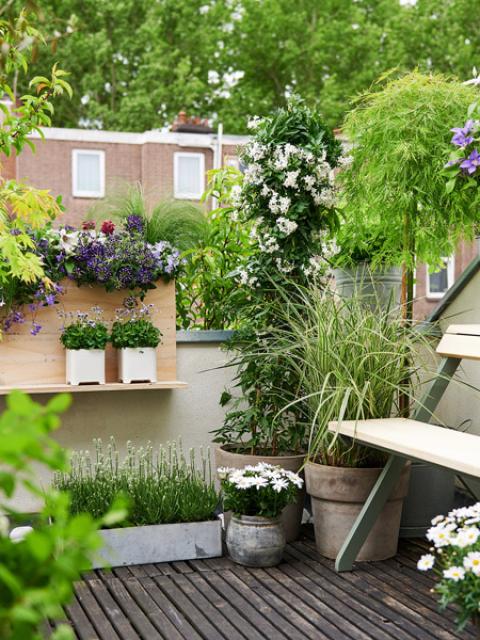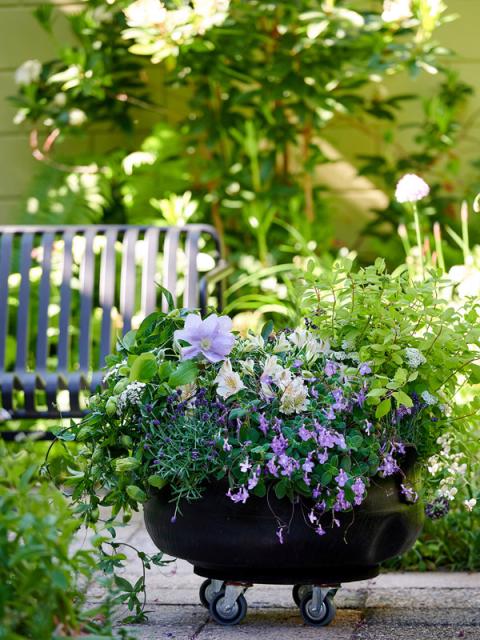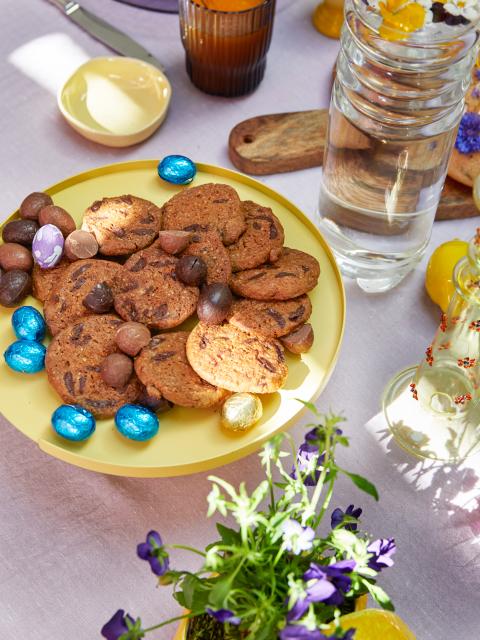WHAT DOES LAVENDER LOOK LIKE?
Lavender is a Mediterranean plant which produces wonderfully fragrant flowers which bloom in summer, usually purple - or, indeed, lavender-coloured. The flowers can also be pink, white or blue in colour. Lavender is a shrub that typically grows around 50-75 centimetres high and 50 centimetres wide. It's characterised by its long stems and grey-green, narrow leaves that are evergreen and hardy. Lavender is a semi-shrub and is part of the Lamiaceae, or lipflower, family. This family also includes other aromatic plants such as thyme, sage and mint.
WHAT VARIETIES OF LAVENDER ARE THERE?
Its pretty look, low-maintenance character, attraction to garden fauna and wonderful scent makes lavender is a very popular garden plant and familiar to many. Did you know, however, that there are around 30 different varieties? These are the three best-known varieties of lavender:
- Lavandula angustifolia: this is also called English lavender, or 'true' lavender. This variety is the hardiest, withstanding temperatures down to -15 degrees celsius, so well adapted even for our often chilly, damp and wintry country, and thus a good pick for our climate. There are many different cultivars within this species, such as 'Dwarf Blue' (with compact growth), Lavender 'Hidcote' (dark purple) and Lavender 'Munstead' (pale purple).
- Lavandula x intermedia: this species is also called Spanish lavender or Lavandin. This lavender has purple-blue flowers and is often used to make lavender oil. Spanish lavender, like the 'true' lavender above, is hardy, but this species grows taller than English and French lavender (up to about 80 centimetres tall). The leaves of this lavender variety are deeper grey-green, and bloom more loosely on longer stems.
- Lavandula stoechas: this species is also called French lavender, crested lavender or butterfly lavender. Lavandula stoechas has a strong scent, striking purple flowers and can be recognised by the lilac-purple crest on top of the flower spike. French lavender is less hardy than other varieties, so in our climate this species is mainly grown in pots. Planted on British soil in open ground, this lavender usually doesn't thrive as it should.
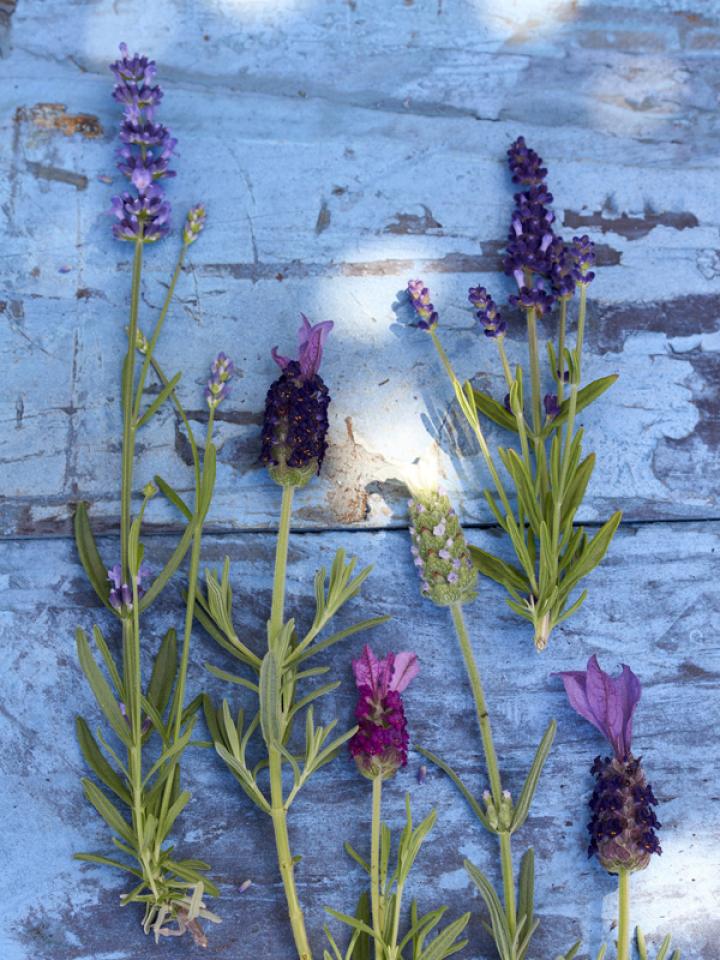
WHEN TO PLANT LAVENDER?
Do you want to plant lavender in your garden, or in pots? You can essentially plant lavender all year round, provided it's not freezing and the ground isn't frozen. When the soil is warm (from around April to September), planting lavender is likely to be most successful. The best time to plant lavender is spring, after the frost and after the weather warms up. The lavender plants will then have enough time to take root, allowing you to enjoy the established plant as early as summer. If you plant lavender during summer, when it is warmer and drier, make sure the plant gets enough water. In autumn, the soil is usually moist enough and lavender needs less manual watering. If you plant lavender in the autumn, you will need some patience, but will enjoy beautifully flowering lavender the following year.
TIPS FOR PLANTING AND CARING FOR LAVENDER
- Plant lavender in a sunny spot. Lavender is a Mediterranean plant that likes warm, dry conditions.
- Make sure the soil is not too moist in order to prevent root rot. If you've had a period of heavy rain, it's a good idea to hold off on planting until the weather dries out.
- You don't need to water lavender when you plant it in your garden unless you plant during the hotter and drier summer months.
- Plant lavender in airy, well-drained soil. There's no need to add fertiliser. If your soil is compact and clay-heavy, considering adding an appropriate planting compost. Ask at a local garden centre for advice on the kind of soil you're working with.
- The planting distance between lavender plants depends on the variety. If you have a dwarf variety such as Hidcote, leave at least 35 centimetres between plants. If you have a larger variety such as Munstead, then the plants can be placed about 45 centimetres apart. This works out to six to nine plants per square metre for the smaller species, and 4-7 plants per square metre for the larger species.
- Add extra lime to your planting mix, as Lavender likes lime-rich soil. Note that butterfly lavender, or crested lavender (Lavendula stoechas) does not require lime, so make sure you check before you plant.
- Give lavender a maintenance dose of lime every year in spring or autumn.
- Are you planting lavender in a pot? Ensure that there's good drainage! Consider adding drainage holes in your pots or using additional drainage methods such hydro grains.
HOW TO PLANT LAVENDER IN YOUR GARDEN
- Once you've found an appropriately sunny spot, dig a planting hole that's twice as wide as the root ball. Don't plant the lavender too deeply. For the depth of the hole, aim for just a little larger than the size of the root ball.
- Loosen the soil in the planting hole and add lime and possibly some compost, depending on the quality of you soil. Lime is always recommended (except for butterfly lavender - see our tips on this above). Compost is especially necessary if your compact has a loamy or clay soil, to make the soil airier and improve drainage.
- Dip the plant root ball in water.
- Place the root ball in the hole and fill the space with soil and/or compost.
- Press the soil down firmly flat and give the plant a nice, big drink of water. You don't need to water your garden lavender after this, unless you plant it during the summer.
WHEN DOES LAVENDER FLOWER?
Lavender is a summer bloomer. It usually blooms from June to September, with the peak flowering period reached in July. The exact flowering period of lavender depends on the variety and the climate.
SHOULD YOU PRUNE LAVENDER?
Yes. Lavender, including young lavender plants, is best pruned twice a year: once in spring (March/April) and once in late summer (August/September), when lavender has generally finished flowering. Don't wait too long to prune, or the plant will stop sprouting. Pruning lavender regularly keeps the plant nice and bushy.
- Lavender pruning in spring (main pruning): after nighttime frosts have finished and the weather begins to warm, give lavender its first pruning of the year. Prune the lavender plant back as deeply as possible, but above a new shoot or offshoot. Do not prune into the wood!
- Lavender pruning in August or September (shape pruning): when your lavender has finished flowering, cut off the spent stems and prune it into shape so that it can go into winter as a nice little compact, happy plant. Don't prune terribly rigorously - save that for spring. Butterfly lavender (also called crested lavender or lavendula stoechas) requires pruning earlier than the more classic lavender, as this species blooms earlier and flowers earlier.
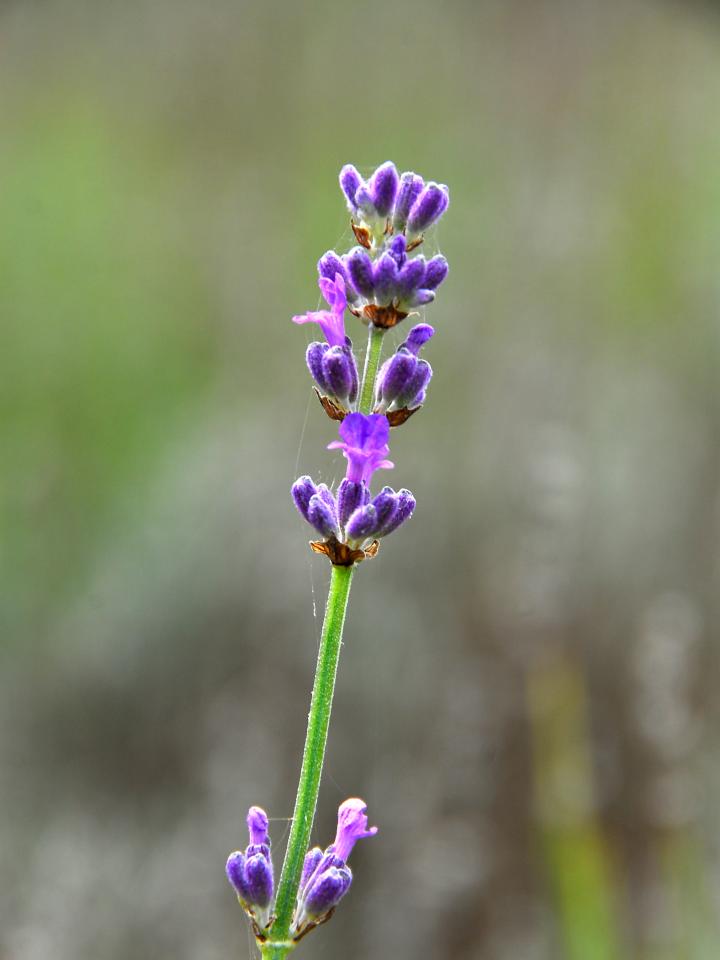
USES AND ORIGINS OF LAVENDER
Lavender, or Lavandula, is native to the Mediterranean region. Lavender is a low, highly branched shrub that originally grew on dry, rocky, calcareous slopes.
The scientific word Lavandula comes from the word lavare, meaning 'wash'. The plant got this name because of the use of lavender in ancient Roman baths. There, lavender was used to combat unpleasant odours and promote relaxation. Lavender and lavender oil have been in use for thousands of years because of their aromatic, calming and medicinal properties.
Today, lavender is a popular plant in gardens around the world. It's used for many different purposes, such as in aromatherapy, as an ingredient in soap and perfume and for culinary uses.
LAVENDER CUTTINGS: HOW TO TRIM YOUR LAVENDER
Can't get enough of lavender and want to propagate your plants? Is your lavender no longer looking so healthy and needs some love, or do you want to make someone happy with a cutting of your beloved plant? Lavender lends itself perfectly to taking cuttings. You should preferably do this in summer so that cuttings have time to take root before winter comes. With the step-by-step plan below, taking lavender cuttings are a piece of cake!
- Fill pots or growing trays with cutting soil.
- Select a healthy mother plant. Check the plant for diseases and pests, then look for non-flowering shoots on the outside of the plant.
- Make a so-called 'heel cutting': pull a side branch from the main stem with a piece of bark (the 'heel') still attached. This is where the new roots of your cutting will grow. Don't have a 'heel'? Then use a sharp knife to cut off the stem just below a leaf node.
- Remove the lower leaves from the cutting so that the lower part is bare, ready to be poked gently into the soil.
- Optional: stick the cutting into some cutting powder to encourage root formation.
- Stick the cutting(s) into the pots or containers, about 2-3 centimetres deep.
- Water well, making the soil moist but not soggy.
- Cover the cuttings with plastic foil or a transparent, or put the lid on the propagator. This will keep the cuttings moist.
- Put the cuttings in a warm, well-lit place (such as inside on a windowsill), but avoid direct sunlight to prevent them from drying out.
- As soon as the first roots grow (usually after a month or so), make a hole in the plastic to provide more ventilation. After a few weeks, remove the plastic and let the cuttings continue to grow.
- When the cuttings are well rooted (a few months after planting), transplant them into individual, larger pots. Put them, sheltered, in a greenhouse or conservatory. In spring, if desired, you can plant them in your garden.
HOW TO ENCOURAGE MORE BUTTERFLIES AND BEES INTO YOUR GARDEN
Lavender is not only popular with people, it's also a favourite plant of bees, butterflies and other pollinators. Lavender contributes to biodiversity and is in the top ten plants most attractive to butterflies. Combine lavender with other butterfly magnets such as ironwort (Verbena) and butterfly bush (Buddleja) and your garden will be a brightly-coloured buzzing party. Here's why the lavender plant is a favourite of butterflies, bees and bumblebees:
- Lavender produces lots of nectar, which is an important food source for bees, butterflies and bumblebees.
- The lavender flowers have a distinctive colour and characteristic scent that attract pollinators.
- Lavender blooms for a long time, so the plant provides food for pollinators for a long period of time.
- Lavender's dense flower clusters and compact growth habit make it easy for friendly bugs to land on the flowers and move from flower to flower while collecting nectar.
IS LAVENDER TOXIC TO PETS?
Lavender is generally not considered to be toxic to pets, however care should still be taken as certain kinds of animal are more sensitive to it than others. Large amounts of lavender can cause stomach upsets in some pets, such as dogs. You don't need to worry about your cat - felines hate the smell of lavender and thus won't touch it. Small rodents such as rabbits and guinea pigs can get lavender poisoning if they gnaw on the plant, due to the high concentration of essential oils. In case of any concerns or adverse reaction, contact your vet.








